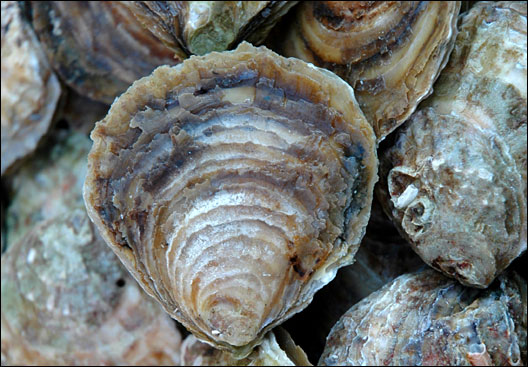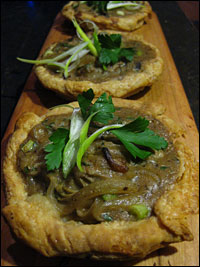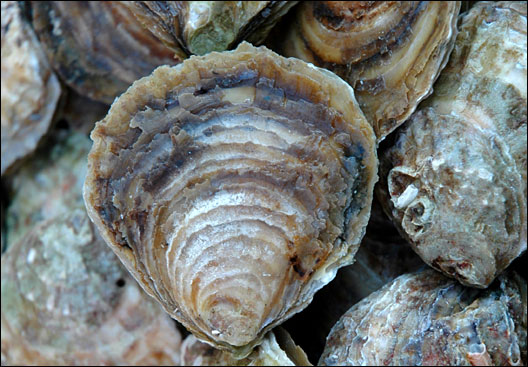
Pearl, interrupted.
I have long been partial to oysters. But it wasn’t until a few years ago that I came to understand the environmental challenges they face.
Many folks assume that water pollution poses the main threat to oysters. Turns out the real damage comes from water scarcity — specifically, a lack of freshwater draining into coastal areas, often due to overdevelopment.
At a Southern Foodways Alliance a couple of years ago, I was lucky enough to hear a talk by Robb Walsh, a Houston-based food journalist. Walsh had heard about the attempts of conservationists and the states that border Chesapeake Bay to rebuild the oyster fishery through tougher controls on pollution, strict limits on oystermen, and the possible introduction of an oyster species from Asia. He’d asked the Texas oyster experts to meet with him to find out what kind of conservation projects were going on to save the oysters of Galveston Bay. He arrived with the commonly held belief that pollution had wiped out most of America’s native oyster reefs around the mid-1900s.
His findings are shocking. Galveston Bay is home to North America’s most productive oyster reefs. It turns out that 2003 and 2005 were the peak harvests of the Galveston Bay oyster fishery.
Galveston-based Marine biologist Sammy Ray, one of the foremost authorities on Gulf oysters, explains that pollution is not a problem for oysters — oysters eat pollution and actually make the water cleaner. What kills oysters is salt water — or, more specifically, the oyster’s pests and diseases that thrive in salt water. (Of course, pollution has a lot of other ill effects, and you surely don’t want to eat an oyster from a bed a few feet from an oil rig.) According to Ray, the real threats to the oyster reefs throughout the Gulf region are housing developments in the floodplains and increasingly erratic weather.
Dam It to Hell
The oyster industry of Apalachicola Bay, Florida, the nation’s most prized oyster appellation, and my personal favorite oyster, is currently being tag teamed by these two largest threats. The Apalachicola River is surrounded by Florida’s largest floodplain, and it is estimated that the discharge from the river into the Gulf of Mexico accounts for 35 percent of the total freshwater contribution from the west coast of Florida. The Bay supplies 10 percent of all oysters harvested nationally.
Apalachicola Bay’s largest threat lies 350 miles upstream: Atlanta’s population explosion. Dams are being built upstream that threaten both freshwater and sediment flow to the bay. Appalachicola Bay Oysterman Tommy Ward feels the encroaching threats on his beloved oyster beds firsthand: “Our way of life is going to be gone as I know it. I guess a new way will come in. But you can put too much pressure on the sanctuary with development with houses, roads, and you got septic tanks or bigger sewer plants, and I don’t know that the bay can withstand all the pressure that’s going to be put on it. You know, that’s what scares me … And it’s coming every day, faster and faster …”
Just recently, three years of negotiations toward an equitable water-sharing compact for the states of Alabama, Florida, and Georgia came to an end. The issue is currently unresolved, and the droughts of recent years have served to compound the problem.
Raw Deal
So is there anything that we can do to effect change in this fight? Organizations like the Apalachicola Riverkeeper and The Nature Conservancy are fighting a hard battle and could use our support. Better urban planning, a campaign to get rid of front lawns, as well as a general water conservation campaign in Atlanta could greatly reduce the city’s water needs.
We can also celebrate the wild oyster. In much of the culinary world, Gulf oysters have been snubbed in recent years and more attention devoted to tiny, cultivated cold-water oysters like Kumamotos and blue points. I admit I like these oysters too, and farm-raised oysters are a very low-impact form of aquaculture. However, I come from a culture where oysters are bought in burlap sacks and enjoyed by the dozens. Three tiny oysters in a fancy white-tablecloth restaurant amounts to little more than a very expensive oyster tease for me.
Plus, Apalachicola and Galveston Bay oysters are just some of the finest-tasting oysters in the world. In the South, it is true that eating oysters from warm waters represents a small health risk. We solve that problem by treating oysters as a seasonal cold-weather food. Little or no V. vulnificus, the bacterium associated with the risk of eating raw oysters, is detectable when the water temperature at the point of collection is below 65 degrees, generally between December and the middle of March.
Respecting the celebrated seasonality of the oyster makes them taste all the sweeter. While they are in season, I try to eat them as often as possible and in as many ways as possible. Raw on the half shell, roasted or grilled, fried, Rockefeller-style, in jambalays, gumbos, dressings, crêpes, gratins, stews, and even pie. I’m sounding a bit like Bubba Gump here, so you’ll have to forgive my enthusiasm for this delectable bivalve.
I have a really hard time choosing my favorite way to eat oysters, so in this recipe I decided to combine two dishes in one — brown oyster stew and oyster pie. Brown oyster stew is a specialty of the Carolina Low Country. It gets its rich and nutty flavor from pounded sesame seeds — or their African name, benne seeds, which still holds sway in South Carolina. I have a particular weakness as well for cute little oyster pies with a buttery crust that perfectly complements the buttery oyster.
This recipe is absolutely delicious and a great way to enjoy the convenience of pre-shucked oysters for those of you who fear cutting your hand off in the shucking process. I do encourage you, however, to explore the wholly sensory experience of shucking your own oysters: the sound of the oysters hitting the sink, the feel of the craggy oyster shell in your hand, the scent of the sea, the brine dribbling down your forearms and then your chin when you reward your shucking effort with a well-deserved slurp. (Here‘s a great video for learning to shuck, and here‘s a guide to choosing the right oyster knife. )
Brown Oyster Pie with Benne (Sesame) Seeds
3 tablespoons toasted benne (sesame) seeds, divided
3 slices, or 1 1/2 ounces, bacon, chopped
2 tablespoons flour
1/4 cup chopped leeks or 1/2 cup of chopped onion
2 tablespoons heavy cream (optional)
1 pint of whole shucked oysters, drained and liquid reserved
1 cup of bottled clam juice
1 bunch of scallions, green tops and whites divided
3 tablespoons chopped Italian parsley, divided
Salt, black pepper, and hot sauce or lemon juice

Toast the sesame seeds in a heavy bottomed sauté pan or cast iron skillet over medium heat. Stir frequently until browned and fragrant. Remove from heat and set aside to cool. When cooled, reserve 1 tablespoon of the sesame see
ds and grind two tablespoons in a mortar and pestle or spice grinder. Set aside.
Thinly slice the scallion whites and set aside two tablespoons. Reserve the rest for another use. Thinly slice the scallion greens on a hard diagonal for a garnish and set aside.
In a heavy bottomed saucepan, sauté the bacon for about five minutes, until browned and crisp. With a slotted spoon, remove the bacon and place on a towel to drain and set aside. In the rendered bacon fat, stir in the two tablespoons of flour and cook, stirring constantly until the flour is browned, about three minutes. Add the leeks and sauté for two more minutes.
Combine the reserved oyster liquor with enough of the bottled clam juice to equal 1 1/2 cups of liquid. Slowly whisk the liquid into the flour until smooth. Return to medium heat and bring to a simmer, stirring constantly until thickened. Stir in the cream and the pounded sesame seeds. Season with salt, black pepper, and a few drops of hot sauce or lemon juice.
Stir in the thinly sliced scallion whites and the reserved oysters.
Ladle the stew into the pre-baked pie shell or into the individual tarts and top with the reserved bacon. Bake at 375 degrees until the edges of the oysters curl, about 15 minutes.
Serve immediately with a leafy green salad.
Basic Pie Crust
Yields one 9-inch pie shell or four 4-inch tarts
1/2 teaspoon kosher salt
10 1/2 tablespoons unsalted butter, cut into 1-inch pieces and frozen for 10
minutes (OR 8 tablespoons unsalted butter plus 2 1/2 tablespoons lard)
1/3 cup ice water
Here are a few tips for ensuring a flaky pie dough: 1) Work the dough very briefly, making sure some of the butter remains in pinto bean-sized pieces. When you roll out your dough, you should see some streaks of butter. 2) Make sure that after you form your pie dough that you chill it very well and let it rest in the freezer for a half hour before baking. 3) Glass or aluminum pie pans yield the best, crispiest pie crust.
Combine the flour and salt in a mixing bowl. Scatter the butter over the flour, and use a pastry blender, a fork, or two knives to cut the butter into the flour until the mixture forms large crumbs and some of the pieces of butter are still the size of dried pinto beans.
Drizzle in the ice water and combine with a fork until the dough begins to come together into a ball but is not completely smooth.
On a lightly floured work surface, shape the ball into a disc about 1 inch thick and wrap well in plastic wrap. Chill the dough at least 2 hours or overnight before rolling out.
Roll out the chilled dough into a circle 1 1/2 inches larger than your pie pan. Line the pan with the dough and trim it with scissors to leave 1/2″ overhang of pie dough around the pan. Fold the dough overhang under, and flute or crimp the edge or leave it plain.
Refrigerate or freeze the dough until ready to use, or at least 30 minutes before baking. The shells may also be wrapped well and frozen for up to two months at this point. It is not necessary to thaw them before baking.
To blind bake the pie crust: Preheat oven to 400 degrees F. Prick the bottom and sides of your pie dough all over with a fork. Line the pie shell with a sheet of aluminum foil or wax paper. Fill the pie shell up to the top edge with dried beans, rice, or pie weights. Bake shell in middle of oven 10 minutes. Remove paper and rice or beans carefully and bake shell until golden, about 12 minutes more. Cool shell in pie plate on a rack.



